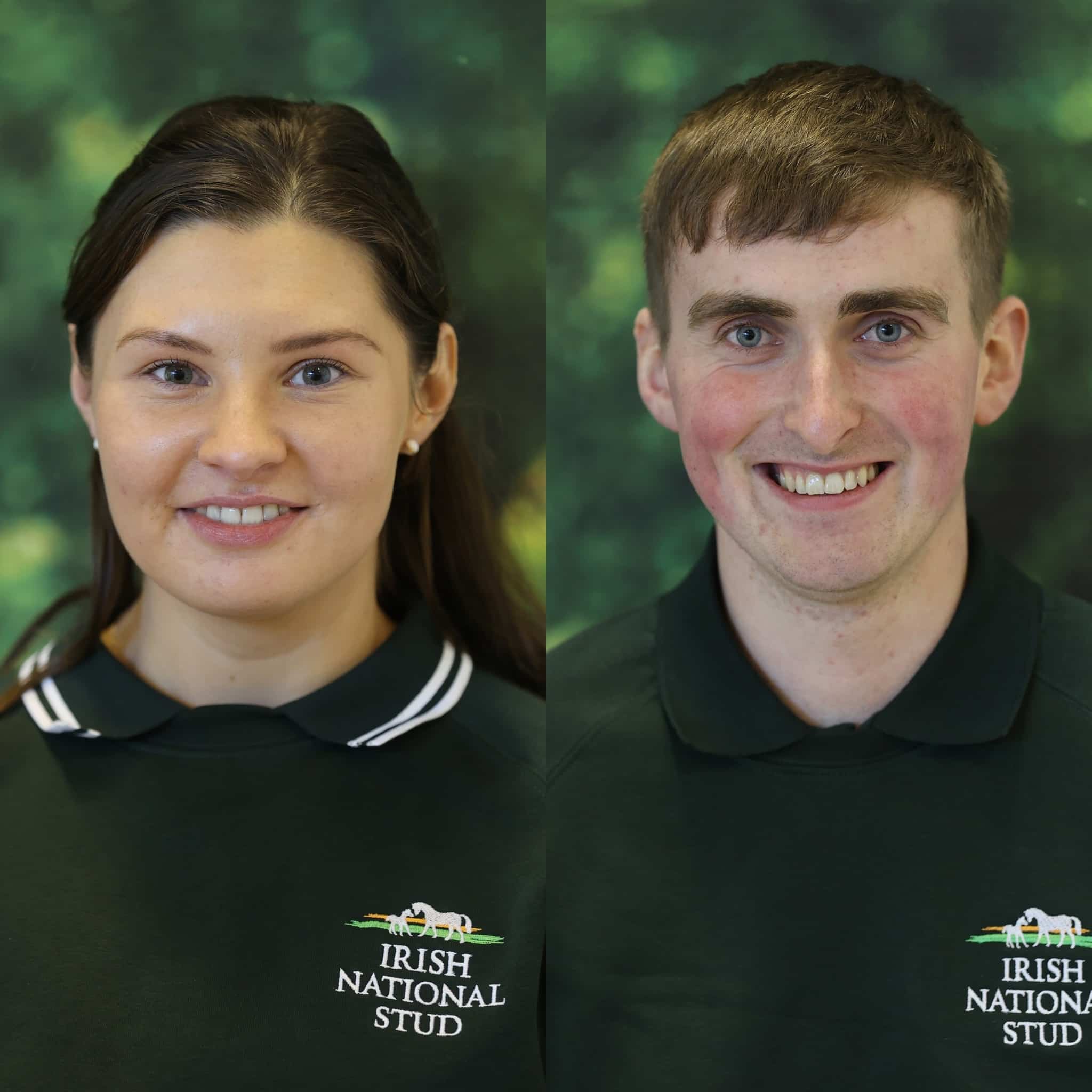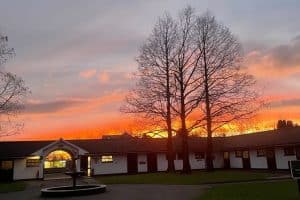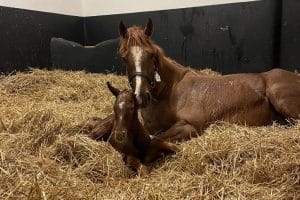
Orla
I recently completed my second rotation of night duty. Foaling is probably the hardest, but most rewarding and educational part of the course. This entailed spending four nights foaling mares from 6pm to 7am. I had only ever worked in my family’s foaling unit before the course, so learning the highly comprehensive foaling procedure of the Irish National Stud sets a perfect standard for me to replicate going forward. We had a relatively quiet time by the busy standards of the foaling unit, by having just six Easter deliveries. While foals may have lacked numerically, they certainly did not lack in size. While all of these newborns were impressive individuals, one foal really stood out as he weighed a whopping 73kg! He is the biggest foal born this year, beating all 159 other foals preceding him. As you can imagine, delivering a foal of this size requires giving a little extra help to the mare. Myself, my classmate Kate Moloney, and the foaling manager, Lauren, assisted the mare by gently pulling the foal with ropes to ease pressure on the mare. Thankfully there were no complications. We gave oxygen to the foal as a precautionary measure, which is something I am not accustomed to doing. I was amazed by how it can brighten up a foal after just a few minutes. I will definitely be taking this knowledge and experience with me for my future career. Following a nice rest after night shifts, I joined Shane and the rest of the team of Kildare Yard under the watchful eye of Laura. This was my first time working here, and I can already say it is one of my favorite yards. Laura runs the yard incredibly efficiently and this has been my biggest take home from this week. Not only is no stone left unturned, the standard of care for each mare and foal is exceptional. Coming from a breeding background, it was really valuable to learn how different studs care for their foals after neonatal stage. In Kildare yard, there are foals ranging in age from a week old to two months old. They are grouped by age in their paddocks, keeping the stronger and older foals with better immune systems away from the the newborns. The novelty of watching foals out in paddocks together playing and gaining their own personalities never loses fascination for me.
Lectures
In terms of lectures, we had a very informative week with an introductory equine nutrition lecturer with Gain’s equine nutrition expert Joanne Hurley where we discussed the importance of diets for breeding stock and sales horses as well as the importance of each dietary element included in a horse’s diet. We look forward to having more in-depth lectures focusing on the dietary needs of broodmares, young stock, and stallions in the following weeks. The biosecurity lecture with Dr. Kevin Corley was a very informative one on such an important topic for anyone working with horses in the future. We discussed in depth the diseases strangles and EHV and learned about the causes, treatments and preventive measures for each disease. Our guest lecturer this week was IHRB’s Senior Flat Handicapper, Garry O’Gorman. This was a very enlightening lecture that taught us about our handicapping system both nationally and internationally. Admittedly, both Shane and I had very limited knowledge of handicapping prior to this lecture, and we have definitely grasped a better understanding and appreciation for it now. What fascinated me was the criteria that were considered in establishing a rating. The criteria seem to differ depending on the circumstances of the race. Generally, a horse will gain a rating after three runs; however, this may be after two or four runs depending on the form of the race or the physique of the horse. The goal of a handicapper is to ensure that every horse is given an equal opportunity to win a race. Garry stated that the “ideal outcome” of handicapping is to have numerous horses in a line at the one-furlong mark, so that they all are in contention of winning the race which creates healthy competition.
Shane
This week I was working in Kildare yard with mares and foals. Prior to this course I had gained experience working with mares and foals, however it was great to see how a different stud operated and I picked up a number of tips during the week. Our yard foreman Laura was very good at teaching us in all aspects, from teasing and scanning mares to dealing with foals. One thing that she is particularly stringent about, and with good reason, is biosecurity. With foals of such a young age in the yard, preventing the spread of any bug or infection is paramount. For this reason, there was an emphasis on glove wearing and foot dips when dealing with sick or scouring foals, as well as regular disinfecting of all stables throughout the week. This coincided perfectly with our evening lectures with Dr. Kevin Corley where we discussed the importance of biosecurity on Irish stud farms and discussed practical examples of where biosecurity issues can arise and how to treat and prevent them. Learning what remedies were used in the Irish National Stud to treat foals that were sick or scouring was also a great learning opportunity and one that I will take with me in my further career. The remedies used here were different to ones I have used before and seemed to work quite well. I was also fortunate one day to be assisting Martin Leahy, our resident farrier, when removing a plastic extension from a foal’s hoof. We had previously learned in Martin’s evening lecture how these extensions function and it was interesting to see how effected they can be. Once the plastic extension was removed the was a clear visual difference in the hoof growth on the area of the hoof where the extension was placed where it had suppressed hoof growth and aided the foot to turn into a more correct conformation. Another interesting learning point of the week was learning about the thermochips used on foals rather than conventual microchips. These microchips’ core purpose is for identification purposes but also have the added advantage of being able to record the temperature of the foal. Therefore, a foal’s temperature can be taken by simply scanning its microchip rather than using a thermometer which lends its hand to biosecurity measures in place at the stud. With it being Easter week, the yard was very busy with tourists. It was amazing to see how quickly some of the foals got confident around the public and would eventually spend most of the day beside the fence getting scratches by all the tourists. This was not only nice to see but also made our lives easier as it made them a lot quieter to handle from an early age.
HAVE A QUESTION?
Drop a Line
Address
Irish National Stud & Gardens,
Brallistown Little, Tully, Co. Kildare,
R51 AP20, Ireland


